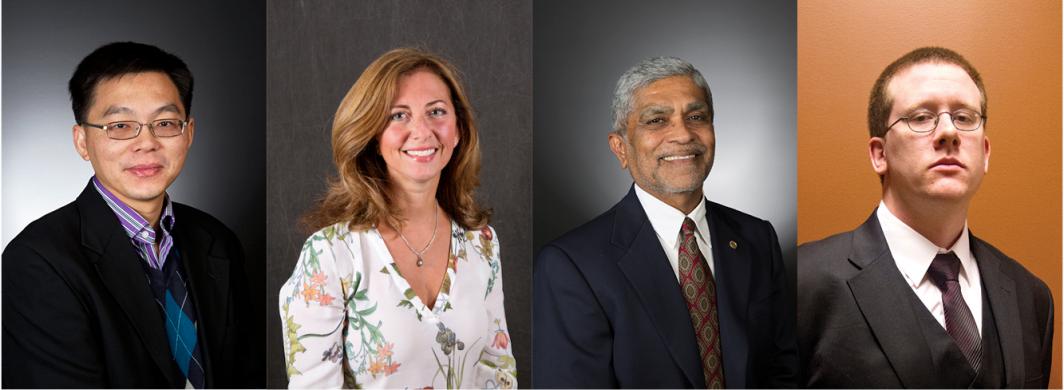Can 50 percent of the power grid come from renewables?

Faculty members in the Ira A. Fulton Schools of Engineering are using a $3 million Department of Energy grant to accelerate technological advancements that improve the coordination between renewables and other resources within the power grid. Photo by Shutterstock.com
Renewable energy is becoming increasingly cost competitive in comparison to traditional fossil-fuel generation. So why is its impact on the power grid limited?
The fact is, renewable-energy sources are inherently variable and uncertain. The wind blows, and then it stops. The sun shines, and then a cloud comes.
Fossil-fuel generators are spared this fluctuation, so the ebbs and flows of renewable generation must be managed differently to remain effective within the power grid.
Arizona State University professors Junshan Zhang, Kory Hedman, Vijay Vittal and Anna Scaglione are utilizing a $3 million U.S. Department of Energy (DOE) grant to accelerate technological advancements that improve the coordination between renewables and other resources within the power grid.
The research team, all faculty members in the Ira A. Fulton Schools of Engineering, is collaborating with Sandia National Laboratories, Nexant Inc. and PJM Interconnection.
What is their guiding philosophy?
You can’t stop the clouds from coming, but you can improve the design of the power grid so that it is better equipped to manage renewable energy and offset the use of fossil fuels.
“It goes against the purpose of integrating clean, renewable resources in the power grid if their fluctuations in power generation must be compensated for by excessive ramping of fossil-fuel units,” said Hedman.
“To depend more on the electric power coming from renewable sources, rather than fossil-fuel generators, we will need to change how the power grid works,” said Scaglione.
Addressing limitations in the power grid
The fluctuating output of renewables makes it difficult for a power-grid operator to forecast how much energy to expect from them.
Because of this, operators generally limit the expected supply of renewably energy to the power grid to satisfy established operating limits.
“In certain cases this could result in renewable energy going unused,” said Vittal, which ends up costing the end consumer more due to the operating cost of expensive emergency reserves.
The ASU grant was one of 12 grants awarded through DOE’s Advanced Research Projects Agency-Energy’s (ARPA-E) Network Optimized Distributed Energy Systems (NODES) program.
Through improved technology and discoveries, the NODES program aims to achieve 50 percent or more of power grid usage from renewable-energy resources.
“The current design of the grid is prepared for the worst-case scenario, so it is a grand challenge for the grid to handle a high renewable penetration level,” said Zhang, electrical engineering professor and principal investigator for the project.
For the ASU team, the goal of their NODES project, titled Stochastic Optimal Power Flow (OPF), is to create a suite of forecasting algorithms to better account for renewable sources at all levels of the power-grid operation process.
“By taking into account the uncertainty associated with renewable resources, the project takes important strides in overcoming key obstacles in integrating renewable resources,” said Vittal.
“This is one of very few efforts focusing on the integration of this kind of variable power into the grid,” said Zhang.
The project focuses on three key areas: better forecasting of the power generation of renewables, real-time management at the grid level, and integrating power generated by consumers into the grid.
The holistic nature of this project, having never been attempted before, promises the unique benefits of a disruptive technological advancement — making it possible to achieve 50 percent renewable-resource penetration in the national power grid.
Improved forecasting capacities and real-time management
Professor Junshan Zhang, principal
investigator of the grant, is creating
a suite of forecasting algorithms
to better account for renewable
sources at all levels of the
power-grid operation process.
Zhang and Vittal have developed a suite of data analytics-based forecasting algorithms for wind and solar generation that improve the forecast accuracy of distributed energy resources (DERs).
DERs, which include renewable technologies, are smaller power sources that can be aggregated to meet power demand.
Since the implementation of DERs into the power grid relies on aggregation, accurate forecasting is paramount.
Zhang anticipates an improvement of more than 20 percent in the forecasting accuracy as a result of his improved algorithms.
By forecasting a statistical distribution of renewable power at a future time, these distributional forecasts better handle uncertainty than the existing “point forecast” paradigm, which gives only the value of renewable power at a future instance in time.
Distributional forecasts enable system operators to maintain an acceptable level of risk, reducing an otherwise wasted system energy reserve.
“More accurate forecasts of DERs give systems operators more flexibility” in determining an optimal output that still meets the economic, operational and system constraints, explained Zhang.
Another component of the project, led by Hedman, is the addition of real-time management at the grid level.
In addition to unprecedented visibility, flexibility and predictability, new stochastic algorithms enable real-time coordination between the DERs, the demand response and distributed storage in a comprehensive approach.
Hedman describes this effort as developing “a standalone tool that advises grid operators on various ancillary services needed to mitigate renewable-resource fluctuations in real-time.”
“By doing so, we are able to avoid the market pricing barriers that exist for stochastic programming, and concurrently enable Stochastic OPF to have an impact,” said Zhang.
Rethinking electric power management
While Zhang, Vittal and Hedman are focused on equipping power-systems operations to handle larger degrees of uncertainty, Scaglione is looking at consumption in the power grid more broadly.
She points out the problem that the supply and demand of electric power must be continuously balanced. For Scaglione, this constraint is as significant as the focus on using energy efficiently.
“As users, we are unaware today of the congestion or [renewable production] shortages that may exist at every instant of time on the grid,” she said.
“Not only must operators manage the uncertainty and variability of renewable resources, but they must also be mindful of congestion limiting the transport of electric power,” said Hedman.
According to the research team, smart energy usage is not necessarily a matter of consuming less power, but rather shifting the use of power to when it is available.
This could include controlling the energy consumption of flexible appliances, such as heating and air-conditioning systems, whose electric power can be shifted in time without people taking notice.
Currently, our air-conditioning systems, for example, turn on and off to maintain customer satisfaction without taking into account fluctuations in the power grid.
“But the consumption of these appliances could be changed to not focus on minimizing energy, but on alleviating congestion in the grid,” said Scaglione. This congestion, or imbalance between appliances and generated power, could be relieved by deferring consumption, rather than turning up or down fossil-fuel generators.
Another example is charging an electric car.
The car needs to be charged when the user intends to drive it, but the charging doesn’t have to start the moment it is plugged into the charger in many cases.
“The hours when our appliances are drawing power can shift or be interrupted without any inconvenience to better take advantage of periods of renewable-energy abundance in the electric grid,” said Scaglione.
Adding electric storage to homes and buildings could also help consumers to better use power when it is available — though an affordable solution to adding electric storage options to households is a reality not yet reached.
“The technological solutions may already exist — the challenge is to make them grid-friendly,” said Scaglione.
To compensate for shortages or surpluses of renewable generation would require power-systems operations to manage thousands to millions of subsystems — electric batteries, air-conditioners, smart lighting, electric vehicle charging and more — instead of a relatively small fleet of large fossil-fuel generators.
Scaglione is developing computational models and interfaces that aim to harmonize the multitude of subsystems within a collective system, allowing better management and understanding of the global state of production in the grid.
“My research envisions how we can treat these subsystems as a large reservoir that can be controlled to follow the ebbs and flows of renewable generation, while delivering the desired performance to the consumer,” she added.
The research team includes ASU professors (from left) Junshan Zhang, Anna Scaglione, Vijay Vittal and Kory Hedman.
Economic and environmental benefits
The team is on track to get more renewable energy into the power grid, and subsequently into people’s homes, businesses and devices, while maintaining reliability and resiliency.
These improvements could dramatically offset thermal generation and reduce carbon dioxide emissions.
This is due to the fact that the grid “will use significantly more renewable resources without posing challenges in the reliability of the power delivery service,” said Scaglione.
“With the newly imposed restrictions by the Environmental Protection Agency, in regards to clean energy, it is imperative to increase the penetration of renewable resources in the grid,” said Vittal.
Economically, improved management could also reduce the amount of power reserves on standby in case of unforeseen intermittency, valued at saving $3.3 billion per year according to ARPA-E.
The effect of this new technology could be game changing, even disruptive, in ushering in a new era in the electric-power industry.
“It will open the floodgates to integration of renewables and other DERs with the knowledge that the full potential of these renewable resources could soon be realized,” said Zhang.
Written by Rose Serago with contributions from Gary Campbell
More Environment and sustainability

A 6-month road repair that only takes 10 days, at a fraction of the cost? It's reality, thanks to ASU concrete research
While Arizona’s infrastructure may be younger than its East Coast counterparts, the effects of aging in a desert climate have…

Mapping DNA of over 1 million species could lead to new medicines, other solutions to human problems
Valuable secrets await discovery in the DNA of Earth’s millions of species, most of them only sketchily understood. Waiting to be…

From road coatings to a sweating manikin, these ASU research projects are helping Arizonans keep their cool
The heat isn’t going away. And neither are sprawling desert cities like the metro Phoenix area.With new summer records being set…



